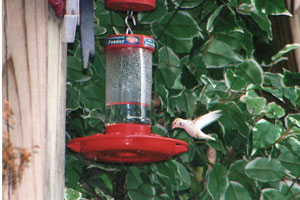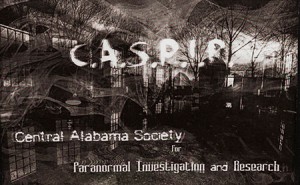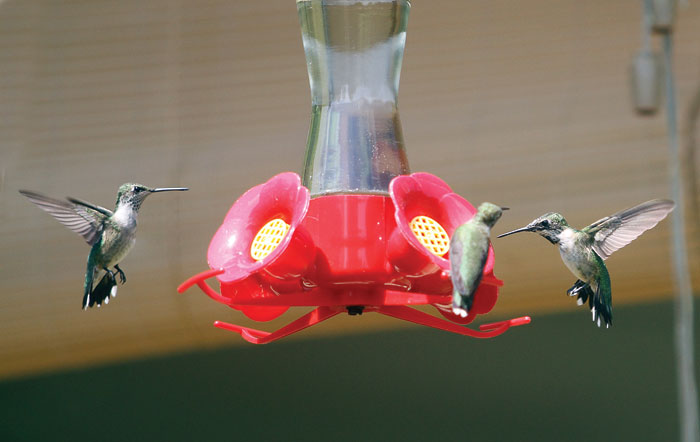
E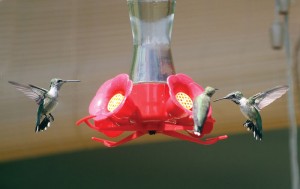 very year, some of the smallest
very year, some of the smallest
birds alive flock to St. Clair County
By Carol Pappas
Photos by Jerry Martin
Close your eyes a minute, and you might think you’re at LaGuardia or some other heavily traveled airport as the whir of the air traffic heads in and out.
But this isn’t LaGuardia, not by a long shot. And that whir you hear? It’s just the yearly flight of the Ruby-throated Hummingbird — hundreds of them — heading in for a good meal at a familiar St. Clair County landing strip.
From the road, there’s not much to distinguish it from other residences in this Chandler Mountain neck of the woods. But step around back, and Bill and Jody Gilliland have quite a surprise in store.
Hanging from the backyard rooftop and dangling from clothes lines are rows and rows of hummingbird feeders, enticing these tiny creatures back year after year like regular customers to a local diner at lunch rush.
And they have been back every year for more than a decade. “They’re fairly loyal if they’re breeding,” Bill Gilliland said. A lot of times, they’ll come on the same date. They’re loyal to their route.
“We just furnish the yard and the birdfeeders is basically what we do,” he said, noting that he dedicates this time of year to keeping dozens of feeders stocked on a daily basis for his winged travelers. It takes about 200 gallons of sugar water a year to feed the thousands of birds in his yard.
“I buy the sugar,” Jody Gilliland said, downplaying her role in the process. Her husband handles the rest.
The Gillilands’ place has now become a hummingbird banding training station, where trackers from across the country and as far away as South America have come to train how to band a bird smaller than a person’s little finger.
According to Brandee Moore, who is a licensed bander living on Chandler Mountain, the tiny, aluminum band with a letter and five identification numbers is slipped onto the bird after a momentary capture, and the number is registered in a computer system so that wherever they travel, their frequent flyer miles can be logged. The band on the leg corresponds to measurements, like their bill, their age and sex. The number will never be given to any other bird, so the recapture can tell the history of that particular bird.
A hummingbird bander is not all that common — only 250 in the U.S.; not much more worldwide — because the bird is so small and has to be handled differently than other birds. To be certified requires a separate designation. And that’s why the Gillilands lend their property each year as a training ground.
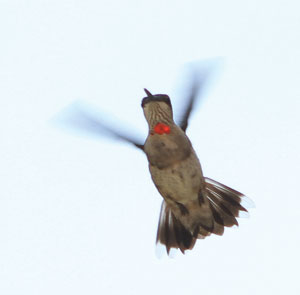 “They like them to band 100 birds here” to ensure that they can build speed and precision during the capture process, Gilliland said.
“They like them to band 100 birds here” to ensure that they can build speed and precision during the capture process, Gilliland said.
And tracking their travels helps those who have an interest to learn about the habits of these fascinating birds. “We probably know about 10 percent,” Gilliland said. “We have lots to learn. But we know a lot more now than we did 30 years ago.”
They first start appearing at the Gillilands each March when migration begins. The male comes first, and the females follow. In late March, they are in full breeding plumage — “iridescent green, like jewels,” Gilliland said.
Thousands will make their way there each year through the end of October. “After Nov. 1, it’s likely not the Ruby Throated Hummingbird,” but some other species, like Rufous, Gilliland said.
By mid-July, traffic starts “picking up,” and in general, they’re all gone by mid to late October.
People who see hummingbirds in their yards generally think it is the same bird over and over again. In reality, though, if a feeder is feeding five birds, it probably is really feeding 25. “There’s a lot more you don’t see. What you see in the yard is four to five times more.
“That’s what we learn from banding.”
Gilliland, a retired State of Alabama engineer, and his wife, who also retired from the state, have always had an interest in birds. They were members of the Ornithological Society and the Audubon Society. They took continuing education classes at the University of Alabama at Birmingham and even taught some through the Audubon Society.
They met Bob and Martha Sargent of Clay, Alabama, who founded The Hummer/Bird Study Group. The group is nonprofit organization founded to study and preserve hummingbirds and other Neo-tropical songbirds. And they have been heavily involved ever since.
HBSG operates banding stations in Clay and Fort Morgan, Alabama. At Fort Morgan in the spring and fall, volunteers capture and band hummingbirds and other species because this coastal area is the first landfall and the last departure point for thousands of migrating birds.
“We are in the hummingbird path, passing through from the north,” said Sargent. From the westernmost point, they come from the eastern slope of the Rocky Mountains in Alberta Province and southern Canada.
From the east, they come from the maritime provinces like Nova Scotia and Labrador, Sargent said. After their “nesting duties, they head south” en route to southern Mexico and northern Panama “and everywhere in between.”
They are not cold-hardy birds, so when temperatures begin their descent, they in essence, “get out of town,” Sargent said. Over land, they stream southward through the Dakotas, Oklahoma and Texas. The eastern part of the population are transgulf migrants on their way to Mexico and Central America this time of year.
He likened them to a broad river, spreading out. “They are not flocking birds. They are independent, ornery, aggressive and mean. They just don’t like each other, but it works for them. That’s the neat thing.”
And that seasonal flight is something they have been doing for uncountable generations, Sargent said, “and the hummingbirds were doing just what they do now.”
Viewer submitted photo/John and Judy Hulsey:





















